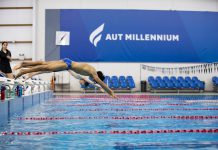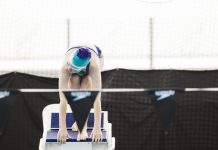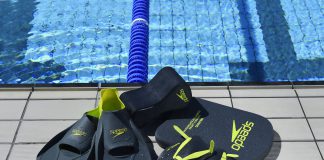When you are at the pool you might see people in the water using a range of equipment, and wonder what the benefits are of using the gear. Training accessories can provide a number of key benefits. When using swim gear correctly, they can isolate muscle groups, improve body position, and alter the intensity of the swim session.
Here at AUT Millennium, we are holding a “try before you buy” week from 2-6 March in the National Aquatic Centre, where you are invited to come in and try out some of the gear to see how you can integrate it into your training. We will have a range of products available for you to try during your swim sessions, along with knowledgeable staff on pool deck to help explain how the gear can be used.
If you have wanted to try swim accessories, but you aren’t quite sure on how to correctly use them, Jacob’s put together a blog series to give you a better understanding and de-mystify swim accessories to help you be the best swimmer you can be!
Paddles
Paddles… You either love them or hate them, but either way you look at them, they can help to increase the potential of your swim.
Paddles are a great tool to use if you are wanting to improve your technique, as they force you to improve the position of your arms in the catch phase of your stroke. You are able to get a range of different sizes and styles of paddles. Some are made for technical purposes, and others are made for power purposes.
Paddles are one of the best ways to increase strength in the water, as they create a larger surface, which in turn can create more resistance. Paddles force you to use a lot of power and with repetition, you will see your strength increase in no time.
What to watch out for: Paddles can put more strain on your arms and you can grow tired faster than usual with the added strain. It is also important to make sure that you are completing the stroke down by your hips.
Things to remember:
- Have a high elbow both in the catch and recovery phase of the stroke.
- Complete the stroke down by your hips.
- Don’t cross the centre line – if you enter in front of your face this can start to impinge your shoulders over time.
- Try not to turn your hand so your thumb is pointing down – maintain a flatter hand in the water for a stronger catch.
Ways to include paddles:
There are a tonne of different ways you can incorporate paddles into your sessions. They are a great accessory to accompany with a pull buoy when you are wanting to work your upper body.
Sets that involve paddles and pull buoys are usually longer distances, as using them doesn’t get your heart rate up as much as kicking does.
Here are some things to try in the pool:
- 6×100 descending 1 – 3 to max on 1.45 – 2:30.
- 4×200 pull on 3min – 4min.
- For the more experienced:
- 5×400 descending 1 – 5 on 6min.
- 12×100 pull as 3x fast, 1x easy on 1.45 – 2:30.
Paddles can also be a great tool if you are wanting to focus on how you are pulling through the water. Paddles can highlight inconsistencies of your pull in the water, and you may notice you aren’t quite doing something right.
Just remember that when you are pulling, you aren’t getting the full body workout. Make sure you include some kicking into your sessions to cover all bases!
Visit New Zealand’s only Speedo concept store on site at AUT Millennium, or shop at our online store.







































